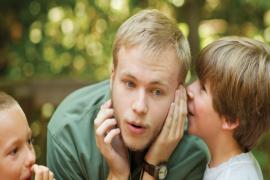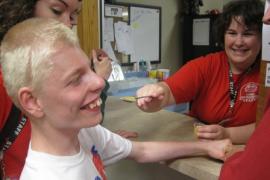Since the outbreak of H1N1 during the summer of 2009, camps have been diligently updating their health and safety protocols and practices for the management of communicable diseases. By accessing and integrating information from the Centers for Disease Control, the American Camp Association® (ACA), the Association of Camp Nurses, and other related resources, camps are improving their health practices by incorporating new knowledge into their day-to-day health center operations.
Camps don't have to wait for an outbreak to occur to update their camp health practices. An important key to developing a sound knowledge base about health and safety conditions is careful monitoring of the factors that cause significant injury and illness events in camps. New information about promising practices of a healthy camp is available now from the Healthy Camp Study, and camps can take advantage of what the camp community has learned to implement proactive health care strategies.
ACA, in cooperation with Nationwide Children's Hospital at The Ohio State University and the Association of Camp Nurses, has completed four years of the five-year Healthy Camp Study, a national injury and illness monitoring program in U.S. camps. Over 170 day and resident camps have participated in the study to date, submitting weekly online reports of significant injury and illness events experienced by campers and staff (See “Monitoring Camp Injuries and Illnesses”). The consistency of the results over the past four years of the study has provided insights into organizational practices for the health and safety of campers and staff. Here are ten practices you can incorporate into your camp operations to improve the well-being of campers and staff involved in your program.
Promising Practice #1
- Research on injury rates from camps and youth sports shows that children are less likely to be injured in day and resident camps than in organized sports in which youth are involved (see Table 1). Fewer than one camper out of 1,000 day campers or 1,000 resident campers become injured, compared with more than four boys sustaining an injury in football, more than two girls sustaining an injury in soccer, and so on.
- Camp professionals should promote the relative safety of the camp experience to parents, caregivers, and the public.
Promising Practice #2
- Campers are more likely to become ill at camp — or to spread a communicable disease —than they are to become injured. One of the most important things parents can do to improve a child's summer camp experience is to keep a child home when he/she is sick.
- Camp professionals should educate parents and caregivers about their role in injury and illness prevention at camp. A parent flyer is available through ACA with key messages for parents.
Promising Practice #3
- Health screening can substantially reduce the adverse illness events in camps.
- Camp professionals should conduct consistent, thorough screening procedures to minimize the potential that ill campers will affect the camp community. Don't forget that screening starts at home when parents decide if their children are well enough to attend camp. Parents should be aware of the camp's or program's criteria for inclusion based on a child's health profile.
Promising Practice #4
- When outbreaks such as H1N1, Norovirus, lice infestation, etc. occur, camps can access a range of reliable resources to effectively manage these situations. Available resources include existing emergency plans, ACA's Crisis Communications Toolkit, and ACA/CDC H1N1 response recommendations.
- Camp professionals should regularly evaluate and update their health-care practices and procedures.
Promising Practice #5
- Don't forget the basics! Remember, the camp experience comes with some unique inherent risks such as slips and falls on uneven surfaces or unfamiliar terrain, which may be different than what children experience in a typical day at home. Directors and staff have critical roles to play in preparing children for a healthy and safe camp experience.
- Camp professionals should make closed-toed shoes and protective equipment mandatory for all applicable activities. No exceptions! Camp professionals should also continue to evaluate slip, trip, and fall hazards.
Promising Practice #6
- Campers and staff continue to sustain injuries associated with knives and other sharp objects.
- Camp professionals should train both paid and volunteer staff (and campers if applicable) how to appropriately handle and store knives. Require staff to attend knife safety training and demonstrate mastery of the safe use of a knife.
Promising Practice #7
- A high percentage of adverse events are occurring in day and resident camps during less structured time (for example, free time) when supervision may vary.
- Camp professionals should clearly define for staff the behaviors that reflect appropriate supervision during less structured time.
Promising Practice #8
- Data from the Healthy Camp Study continue to point to fatigue as a contributing factor to injury and illness. Furthermore, camp staff are sustaining injuries after lights out.
- Camp professionals should develop staff policies that reinforce how important it is that staff take proper care of themselves, including sufficient amounts of rest.
Promising Practice #9
- ACA provides a wide range of educational resources to help camp professionals and parents make good health-related decisions for children, including online injury and illness prevention courses, which can be effective in reducing injuries in targeted areas.
- Camp professionals should access and incorporate ACA injury and illness prevention information and resources.
Promising Practice #10
- ACA's Healthy Camp Study and related surveillance data have created a foundation of evidence-based knowledge for decision-making both for individual camps/programs and system wide, and has established ACA's credibility within the larger health community. Camps participating in the Healthy Camp Study in the summer of 2010 will receive a free CD copy of ACA's injury and illness prevention e-courses.
- Camp professionals should get involved in the study and leverage the credibility that involvement brings to participating camps/programs.
Monitoring Camp Injuries and Illnesses
 The Healthy Camp Study, funded by the Markel Insurance Company — an ACA Mission Partner, is the only national study of camper and staff injuries and illnesses. The study began in 2006 and will end after the 2010 camp season. The goals of the study are to improve the overall camper experience, improve staff effectiveness, and eventually, to lower camp health-care costs. Using an online reporting tool (CAMP RIO™), “reporters” identified at each participating camp (e.g., director, camp physicians, nurses, EMTs, other health-care staff) entered injury and illness data for campers and staff for each week of summer camp. Not every injury and illness was entered into CAMP RIO — only those that matched specific criteria. For day camps, injuries and illnesses that took campers and staff out of the camp experience for more than one hour were included. For resident camps, an injury or illness had to take campers and staff out of the camp experience for more than four hours to be included in the study. At the end of each summer of the Healthy Camp Study, each participating camp received an injury and illness report specific for that camp and a national summary from all reporting camps, which they can use for health and risk management planning. Information about enrolling in the Healthy Camp Study can be found at the end of this article.
The Healthy Camp Study, funded by the Markel Insurance Company — an ACA Mission Partner, is the only national study of camper and staff injuries and illnesses. The study began in 2006 and will end after the 2010 camp season. The goals of the study are to improve the overall camper experience, improve staff effectiveness, and eventually, to lower camp health-care costs. Using an online reporting tool (CAMP RIO™), “reporters” identified at each participating camp (e.g., director, camp physicians, nurses, EMTs, other health-care staff) entered injury and illness data for campers and staff for each week of summer camp. Not every injury and illness was entered into CAMP RIO — only those that matched specific criteria. For day camps, injuries and illnesses that took campers and staff out of the camp experience for more than one hour were included. For resident camps, an injury or illness had to take campers and staff out of the camp experience for more than four hours to be included in the study. At the end of each summer of the Healthy Camp Study, each participating camp received an injury and illness report specific for that camp and a national summary from all reporting camps, which they can use for health and risk management planning. Information about enrolling in the Healthy Camp Study can be found at the end of this article.
Barry Garst, Ph.D., is the former director of program development and research application for the American Camp Association.
Linda Ebner Erceg, R.N., M.S., P.H.N, is the associate director for health and risk management for Concordia Language Villages and executive director of the Association of Camp Nurses in Bemidji, Minnesota. She may be contacted at [email protected].
Susan Baird, R.N., M.P.H., a retired camp nurse, is Editor, CompassPoint, Association of Camp Nurses and chairs the Healthy Camp Study Advisory Committee. She may be contacted at [email protected].
Sandra (Sam) Thompson, C.P.R.P., has been a recreation supervisor for the Crystal Lake Park District for twenty-four years. She is an American Camp Association visitor and a medic first aid instructor. Her writing has appeared in the Illinois Park and Recreation Magazine. She may be contacted at [email protected].
Originally published in the 2010 March/April issue of Camping Magazine.


